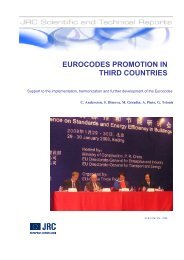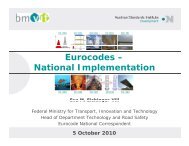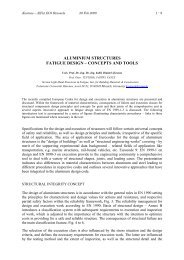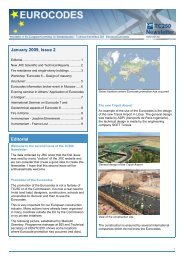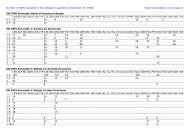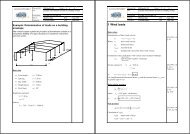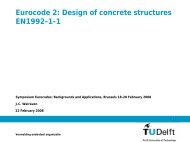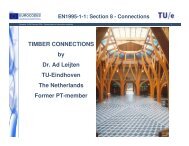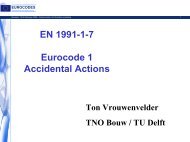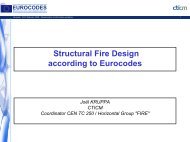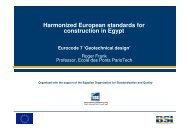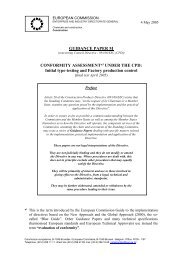EN 1991 – Eurocode 1: Actions on structures Part 1-6 ... - Eurocodes
EN 1991 – Eurocode 1: Actions on structures Part 1-6 ... - Eurocodes
EN 1991 – Eurocode 1: Actions on structures Part 1-6 ... - Eurocodes
Create successful ePaper yourself
Turn your PDF publications into a flip-book with our unique Google optimized e-Paper software.
EUROCODESBackground and Applicati<strong>on</strong>s<str<strong>on</strong>g>EN</str<strong>on</strong>g> <str<strong>on</strong>g>1991</str<strong>on</strong>g>-1-6: C<strong>on</strong>tentsBrussels, 18-20 February 2008 <str<strong>on</strong>g>–</str<strong>on</strong>g> Disseminati<strong>on</strong> of informati<strong>on</strong> workshop 3Secti<strong>on</strong> 4 Representati<strong>on</strong> of acti<strong>on</strong>s4.1 General4.2 <str<strong>on</strong>g>Acti<strong>on</strong>s</str<strong>on</strong>g> <strong>on</strong> structural and n<strong>on</strong> structural members duringhandling4.3 Geotechnical <str<strong>on</strong>g>Acti<strong>on</strong>s</str<strong>on</strong>g>4.4 <str<strong>on</strong>g>Acti<strong>on</strong>s</str<strong>on</strong>g> due to prestresssing4.5 Predeformati<strong>on</strong>s4.6 Temperature, shrinkage, hydrati<strong>on</strong> effects4.7 Wind <str<strong>on</strong>g>Acti<strong>on</strong>s</str<strong>on</strong>g>4.8 Snow Loads4.9 <str<strong>on</strong>g>Acti<strong>on</strong>s</str<strong>on</strong>g> caused by water4.10 <str<strong>on</strong>g>Acti<strong>on</strong>s</str<strong>on</strong>g> due to atmospheric icing4.11 C<strong>on</strong>structi<strong>on</strong> loads4.12 Accidental <str<strong>on</strong>g>Acti<strong>on</strong>s</str<strong>on</strong>g>4.13 Seismic <str<strong>on</strong>g>Acti<strong>on</strong>s</str<strong>on</strong>g>Paolo Formichi, University of Pisa Italy
EUROCODESBackground and Applicati<strong>on</strong>s<str<strong>on</strong>g>EN</str<strong>on</strong>g> <str<strong>on</strong>g>1991</str<strong>on</strong>g>-1-6: AnnexesBrussels, 18-20 February 2008 <str<strong>on</strong>g>–</str<strong>on</strong>g> Disseminati<strong>on</strong> of informati<strong>on</strong> workshop 4Annex A1(Normative)Supplementary rules for buildingsAnnexe A2 (Normative)Supplementary rules for bridgesAnnexe B(Informative)<str<strong>on</strong>g>Acti<strong>on</strong>s</str<strong>on</strong>g> <strong>on</strong> <strong>structures</strong> during alterati<strong>on</strong>,rec<strong>on</strong>structi<strong>on</strong> or demoliti<strong>on</strong>Paolo Formichi, University of Pisa Italy
EUROCODESBackground and Applicati<strong>on</strong>s<str<strong>on</strong>g>EN</str<strong>on</strong>g> <str<strong>on</strong>g>1991</str<strong>on</strong>g>-1-6: Design Situati<strong>on</strong>s and limit statesBrussels, 18-20 February 2008 <str<strong>on</strong>g>–</str<strong>on</strong>g> Disseminati<strong>on</strong> of informati<strong>on</strong> workshop 7Any selected transient design situati<strong>on</strong> be associated with anominal durati<strong>on</strong> equal to, or greater than the anticipateddurati<strong>on</strong> of the stage of executi<strong>on</strong> under c<strong>on</strong>siderati<strong>on</strong>.The design situati<strong>on</strong>s should take into account the likelihoodfor any corresp<strong>on</strong>ding return periods of variable acti<strong>on</strong>s (e.g.climatic acti<strong>on</strong>s).The return periods for the assessment of characteristic valuesof variable acti<strong>on</strong>s during executi<strong>on</strong> may be defined in theNati<strong>on</strong>al Annex or for the individual project.Recommended return periods of climatic acti<strong>on</strong>s are given,depending <strong>on</strong> the nominal durati<strong>on</strong> of the relevant designsituati<strong>on</strong>.Paolo Formichi, University of Pisa Italy
EUROCODESBackground and Applicati<strong>on</strong>s<str<strong>on</strong>g>EN</str<strong>on</strong>g> <str<strong>on</strong>g>1991</str<strong>on</strong>g>-1-6: Design Situati<strong>on</strong>s and limit statesBrussels, 18-20 February 2008 <str<strong>on</strong>g>–</str<strong>on</strong>g> Disseminati<strong>on</strong> of informati<strong>on</strong> workshop 8Nominal durati<strong>on</strong> of the executi<strong>on</strong> phaseReturn period (years)A minimum wind velocity during executi<strong>on</strong> may be defined in the Nati<strong>on</strong>al Annex orfor the individual project. The recommended basic value for durati<strong>on</strong>s of up to 3m<strong>on</strong>ths is 20m/s in accordance with <str<strong>on</strong>g>EN</str<strong>on</strong>g> <str<strong>on</strong>g>1991</str<strong>on</strong>g>-1-4: Wind <str<strong>on</strong>g>Acti<strong>on</strong>s</str<strong>on</strong>g>.Relati<strong>on</strong>ships between characteristic values and return period for climatic acti<strong>on</strong>sare given in the appropriate <strong>Part</strong>s of <str<strong>on</strong>g>EN</str<strong>on</strong>g> <str<strong>on</strong>g>1991</str<strong>on</strong>g>.Paolo Formichi, University of Pisa Italy
EUROCODESBackground and Applicati<strong>on</strong>s<str<strong>on</strong>g>EN</str<strong>on</strong>g> <str<strong>on</strong>g>1991</str<strong>on</strong>g>-1-6: Design Situati<strong>on</strong>s and limit statesBrussels, 18-20 February 2008 <str<strong>on</strong>g>–</str<strong>on</strong>g> Disseminati<strong>on</strong> of informati<strong>on</strong> workshop 9Example: Snow loads according to return period[Annex D of <str<strong>on</strong>g>EN</str<strong>on</strong>g> <str<strong>on</strong>g>1991</str<strong>on</strong>g>-1-3]If the available data show that the annual maximum snow load can beassumed to follow a Gumbel probability distributi<strong>on</strong>, then therelati<strong>on</strong>ship between the characteristic value of the snow load <strong>on</strong> theground and the snow load <strong>on</strong> the ground for a mean recurrenceinterval of n years is given by:s kP nVsn=sk⎧⎪1−V⎨⎪⎪⎩6π[ ln( − ln(1 − P )) + 0,57722](1 + 2,5923V)is the characteristic snow load <strong>on</strong> the ground (with areturn period of 50 years)is the annual probability of exceedence (approx. = 1/n)is the coefficient of variati<strong>on</strong> of annual max. snow loadsn⎫⎪⎬⎪⎪⎭Paolo Formichi, University of Pisa Italy
EUROCODESBackground and Applicati<strong>on</strong>s<str<strong>on</strong>g>EN</str<strong>on</strong>g> <str<strong>on</strong>g>1991</str<strong>on</strong>g>-1-6: Design Situati<strong>on</strong>s and limit statesBrussels, 18-20 February 2008 <str<strong>on</strong>g>–</str<strong>on</strong>g> Disseminati<strong>on</strong> of informati<strong>on</strong> workshop 10Snow loads according to return period[<str<strong>on</strong>g>EN</str<strong>on</strong>g> <str<strong>on</strong>g>1991</str<strong>on</strong>g>-1-3]1.001.000.900.900.800.800.700.70V = 0.2V = 0.6s n /s k0.600.600.500.500.400.400.300.300.200.200 5 10 15 20 25 30 35 40 45 500 5 10 15 20 25 30 35 40 45 50Return period (years)Paolo Formichi, University of Pisa Italy
EUROCODESBackground and Applicati<strong>on</strong>s<str<strong>on</strong>g>EN</str<strong>on</strong>g> <str<strong>on</strong>g>1991</str<strong>on</strong>g>-1-6: Ultimate Limit StatesBrussels, 18-20 February 2008 <str<strong>on</strong>g>–</str<strong>on</strong>g> Disseminati<strong>on</strong> of informati<strong>on</strong> workshop 11Ultimate limit states need to be verified for all selected transient,accidental and seismic design situati<strong>on</strong>s as appropriate duringexecuti<strong>on</strong> in accordance with <str<strong>on</strong>g>EN</str<strong>on</strong>g> 1990.The combinati<strong>on</strong>s of acti<strong>on</strong>s for accidental design situati<strong>on</strong>s can eitherinclude the accidental acti<strong>on</strong> explicitly or refer to a situati<strong>on</strong> after anaccidental event.Generally, accidental design situati<strong>on</strong>s refer to excepti<strong>on</strong>al c<strong>on</strong>diti<strong>on</strong>sapplicable to the structure or its exposure, such as: impact, local failure and subsequent progressive collapse, fall of structural or n<strong>on</strong>-structural parts, and, in the case of buildings, abnormal c<strong>on</strong>centrati<strong>on</strong>s of buildingequipment and/or building materials, water accumulati<strong>on</strong> <strong>on</strong> steelroofs, fire, etc.Paolo Formichi, University of Pisa Italy
EUROCODESBackground and Applicati<strong>on</strong>s<str<strong>on</strong>g>EN</str<strong>on</strong>g> <str<strong>on</strong>g>1991</str<strong>on</strong>g>-1-6: Ultimate Limit StatesBrussels, 18-20 February 2008 <str<strong>on</strong>g>–</str<strong>on</strong>g> Disseminati<strong>on</strong> of informati<strong>on</strong> workshop 12The verificati<strong>on</strong>s of the structure should take into accountthe appropriate geometry and resistance of the partiallycompleted structure corresp<strong>on</strong>ding to the selected designsituati<strong>on</strong>s.Geometry of the partiallycompleted resisting structureResistance of the lower floor, whichhas not necessarily attained its fullstrength.Paolo Formichi, University of Pisa Italy
EUROCODESBackground and Applicati<strong>on</strong>s<str<strong>on</strong>g>EN</str<strong>on</strong>g> <str<strong>on</strong>g>1991</str<strong>on</strong>g>-1-6: Ultimate Limit StatesBrussels, 18-20 February 2008 <str<strong>on</strong>g>–</str<strong>on</strong>g> Disseminati<strong>on</strong> of informati<strong>on</strong> workshop 13geometryresistance1987 <str<strong>on</strong>g>–</str<strong>on</strong>g> Bridgeport C<strong>on</strong>necticut (US)Inadequate temporary c<strong>on</strong>necti<strong>on</strong>s +instability of steel members (*)(*) K. Carper “Beware of vulnerabilities during c<strong>on</strong>structi<strong>on</strong>” -C<strong>on</strong>structi<strong>on</strong> and equipment, 3/20041973 - Bailey’s Crossroad <str<strong>on</strong>g>–</str<strong>on</strong>g> Fairfax (US)C<strong>on</strong>structi<strong>on</strong> of a 26-story building.C<strong>on</strong>crete was being placed at the 24 th floor andshoring was simultaneously being removed atthe 22 nd floor cast two weeks before.Insufficient shear resistance of c<strong>on</strong>crete slabscaused progressive collapse (*)Paolo Formichi, University of Pisa Italy
EUROCODESBackground and Applicati<strong>on</strong>s<str<strong>on</strong>g>EN</str<strong>on</strong>g> <str<strong>on</strong>g>1991</str<strong>on</strong>g>-1-6: Ultimate Limit StatesBrussels, 18-20 February 2008 <str<strong>on</strong>g>–</str<strong>on</strong>g> Disseminati<strong>on</strong> of informati<strong>on</strong> workshop 14Ultimate limit states of STR/GEO - Fundamentalcombinati<strong>on</strong> for transient design situati<strong>on</strong>s.Expressi<strong>on</strong> (6.10) <str<strong>on</strong>g>EN</str<strong>on</strong>g> 1990∑∑γG, jGk, j"+ " γPP"+ " γQ,1Qk,1"+ "j≥ 1 i>1γQ,iψ0, iQk , iExpressi<strong>on</strong>s (6.10a) and (6.10b) <str<strong>on</strong>g>EN</str<strong>on</strong>g> 1990⎧⎪⎨⎪⎩∑j≥1∑j≥1γξG,jjγGG,jk , jG" + " γk , j0,85 ≤ ξ ≤ 1,00P" + " γP"+ "P∑i≥1P"+ " γγQ,iQ,1ψQ0, ik ,1Qk , i" + "∑i>1γQ,iψ0, iQk , iPaolo Formichi, University of Pisa Italy
EUROCODESBackground and Applicati<strong>on</strong>s<str<strong>on</strong>g>EN</str<strong>on</strong>g> <str<strong>on</strong>g>1991</str<strong>on</strong>g>-1-6: Ultimate Limit StatesBrussels, 18-20 February 2008 <str<strong>on</strong>g>–</str<strong>on</strong>g> Disseminati<strong>on</strong> of informati<strong>on</strong> workshop 15Accidental design situati<strong>on</strong>Expressi<strong>on</strong> (6.11b) <str<strong>on</strong>g>EN</str<strong>on</strong>g> 1990∑∑Gk, j"+ " P"+ " Ad" + "(1,1or2,1)Qk,1"+ "j≥ 1 i>1ψψψ2, iQk , iSeismic design situati<strong>on</strong>Expressi<strong>on</strong> (6.12b) <str<strong>on</strong>g>EN</str<strong>on</strong>g> 1990∑∑Gk, j"+ " P"+ " AEd" + "j≥ 1 i>1ψ2, iQk,iPaolo Formichi, University of Pisa Italy
EUROCODESBackground and Applicati<strong>on</strong>s<str<strong>on</strong>g>EN</str<strong>on</strong>g> <str<strong>on</strong>g>1991</str<strong>on</strong>g>-1-6: Serviceability Limit StatesBrussels, 18-20 February 2008 <str<strong>on</strong>g>–</str<strong>on</strong>g> Disseminati<strong>on</strong> of informati<strong>on</strong> workshop 16The SLS for the selected design situati<strong>on</strong>s duringexecuti<strong>on</strong> needs to be verified, as appropriate, inaccordance with <str<strong>on</strong>g>EN</str<strong>on</strong>g> 1990.The criteria associated with the SLS during executi<strong>on</strong>should take into account the requirements for thecompleted structure.Operati<strong>on</strong>s which can cause excessive cracking and/orearly deflecti<strong>on</strong> during executi<strong>on</strong> and which may adverselyaffect the durability, fitness for use and/or aestheticappearance in the final stage has to be avoided.Paolo Formichi, University of Pisa Italy
EUROCODESBackground and Applicati<strong>on</strong>s<str<strong>on</strong>g>EN</str<strong>on</strong>g> <str<strong>on</strong>g>1991</str<strong>on</strong>g>-1-6: Serviceability Limit StatesBrussels, 18-20 February 2008 <str<strong>on</strong>g>–</str<strong>on</strong>g> Disseminati<strong>on</strong> of informati<strong>on</strong> workshop 17The combinati<strong>on</strong>s of acti<strong>on</strong>s should be established inaccordance with <str<strong>on</strong>g>EN</str<strong>on</strong>g> 1990. In general, the relevantcombinati<strong>on</strong>s of acti<strong>on</strong>s for transient design situati<strong>on</strong>sduring executi<strong>on</strong> are:the characteristic combinati<strong>on</strong>the quasi-permanent combinati<strong>on</strong>Paolo Formichi, University of Pisa Italy
EUROCODESBackground and Applicati<strong>on</strong>s<str<strong>on</strong>g>EN</str<strong>on</strong>g> <str<strong>on</strong>g>1991</str<strong>on</strong>g>-1-6: Serviceability Limit StatesBrussels, 18-20 February 2008 <str<strong>on</strong>g>–</str<strong>on</strong>g> Disseminati<strong>on</strong> of informati<strong>on</strong> workshop 18∑SLS: : combinati<strong>on</strong>s of acti<strong>on</strong>s.Characteristic combinati<strong>on</strong> (irreversible SLS)∑Gk, j"+ " P"+ " Qk,1"+ "j≥ 1 i>1ψ0, iQk , iQuasi-permanent combinati<strong>on</strong> (reversible SLS)∑∑Gk, j"+ " P"+ "j≥1 i≥1ψ2, iQk , iPaolo Formichi, University of Pisa Italy
EUROCODESBackground and Applicati<strong>on</strong>sClassificati<strong>on</strong> & representati<strong>on</strong> of acti<strong>on</strong>sBrussels, 18-20 February 2008 <str<strong>on</strong>g>–</str<strong>on</strong>g> Disseminati<strong>on</strong> of informati<strong>on</strong> workshop 19<str<strong>on</strong>g>Acti<strong>on</strong>s</str<strong>on</strong>g> during executi<strong>on</strong> are classified in accordance with<str<strong>on</strong>g>EN</str<strong>on</strong>g> 1990, and may include:those acti<strong>on</strong>s that are not c<strong>on</strong>structi<strong>on</strong> loads; andc<strong>on</strong>structi<strong>on</strong> loadsBoth types of acti<strong>on</strong>s are classified (tables 2.1 and 2.2)depending <strong>on</strong>:Variati<strong>on</strong> in time (permanent, variable, accidental)Origin (direct, indirect)Spatial variati<strong>on</strong> (fixed, free)Nature (static, dynamic)Paolo Formichi, University of Pisa Italy
EUROCODESBackground and Applicati<strong>on</strong>sClassificati<strong>on</strong> & representati<strong>on</strong> of acti<strong>on</strong>sBrussels, 18-20 February 2008 <str<strong>on</strong>g>–</str<strong>on</strong>g> Disseminati<strong>on</strong> of informati<strong>on</strong> workshop 20Paolo Formichi, University of Pisa Italy
EUROCODESBackground and Applicati<strong>on</strong>sC<strong>on</strong>structi<strong>on</strong> LoadsBrussels, 18-20 February 2008 <str<strong>on</strong>g>–</str<strong>on</strong>g> Disseminati<strong>on</strong> of informati<strong>on</strong> workshop 21C<strong>on</strong>structi<strong>on</strong> loads Q c may be represented in theappropriate design situati<strong>on</strong>s (see <str<strong>on</strong>g>EN</str<strong>on</strong>g> 1990), either, as <strong>on</strong>esingle variable acti<strong>on</strong>, or where appropriate different types ofc<strong>on</strong>structi<strong>on</strong> loads may be grouped and applied as a singlevariable acti<strong>on</strong>. Single and/or a grouping of c<strong>on</strong>structi<strong>on</strong>loads should be c<strong>on</strong>sidered to act simultaneously with n<strong>on</strong>c<strong>on</strong>structi<strong>on</strong> loads as appropriate.Q caQ cbQ ccQ cdQ ceQ cf6 different sourcesPaolo Formichi, University of Pisa Italy
EUROCODESBackground and Applicati<strong>on</strong>sClassificati<strong>on</strong> of C<strong>on</strong>structi<strong>on</strong> LoadsBrussels, 18-20 February 2008 <str<strong>on</strong>g>–</str<strong>on</strong>g> Disseminati<strong>on</strong> of informati<strong>on</strong> workshop 22C<strong>on</strong>structi<strong>on</strong> loads Q c are classified as variable acti<strong>on</strong>sC<strong>on</strong>str.LoadQ caQ cbQ ccQ cdQ ceQ cfWhere C<strong>on</strong>structi<strong>on</strong> Loads are classified as fixed, they should be definedtolerances for possible deviati<strong>on</strong> from the theoretical positi<strong>on</strong>.Where C<strong>on</strong>structi<strong>on</strong> Loads are classified as free, they should be defined limits ofthe area where they should be moved or positi<strong>on</strong>ed.Paolo Formichi, University of Pisa Italy
EUROCODESBackground and Applicati<strong>on</strong>sRepresentati<strong>on</strong> of C<strong>on</strong>structi<strong>on</strong> LoadsBrussels, 18-20 February 2008 <str<strong>on</strong>g>–</str<strong>on</strong>g> Disseminati<strong>on</strong> of informati<strong>on</strong> workshop 23C<strong>on</strong>structi<strong>on</strong> loads Q ca Pers<strong>on</strong>nel and hand toolsWorking pers<strong>on</strong>nel, staff and visitors, possibly with hand toolsor other small site equipment.Modelled as a uniformly distributed load q ca and applied as to obtainthe most unfavourable effects.The recommended value is : q ca,k = 1,0 kN/m 2Paolo Formichi, University of Pisa Italy
EUROCODESBackground and Applicati<strong>on</strong>sRepresentati<strong>on</strong> of C<strong>on</strong>structi<strong>on</strong> LoadsBrussels, 18-20 February 2008 <str<strong>on</strong>g>–</str<strong>on</strong>g> Disseminati<strong>on</strong> of informati<strong>on</strong> workshop 24C<strong>on</strong>structi<strong>on</strong> loads Q ca Pers<strong>on</strong>nel and hand toolsThe recommended value has been derived from investigati<strong>on</strong>s <strong>on</strong>c<strong>on</strong>structi<strong>on</strong> sites(*), with regard to the following stages of c<strong>on</strong>structi<strong>on</strong>:1. before pouring of c<strong>on</strong>crete slab;2. after pouring of c<strong>on</strong>crete slab, during the preparati<strong>on</strong> of the next floor.Measurementgrid size [m 2 ]2,325,959,2520,9037,16Mean Load[kN/m 2 ]0,310,300,290,300,2810% fractileLoad [kN/m 2 ]As an example: the 5% fractile value for the 9,25 m 2 , is 1,23 kN/m 2 (Gumbeldistributi<strong>on</strong> of the random variable is assumed).1,080,920,800,730,721% fractileLoad [kN/m 2 ](*) “Cast-in-place C<strong>on</strong>crete in Tall Building Design and C<strong>on</strong>structi<strong>on</strong>” <str<strong>on</strong>g>–</str<strong>on</strong>g> Council <strong>on</strong> Tall Buildings and UrbanHabitat Committee 21 D. Mc Graw-Hill Inc. <str<strong>on</strong>g>–</str<strong>on</strong>g> <str<strong>on</strong>g>1991</str<strong>on</strong>g> <str<strong>on</strong>g>–</str<strong>on</strong>g> Chapter 2: C<strong>on</strong>structi<strong>on</strong> loads.2,932,002,181,581,430,5% fractileLoad [kN/m 2 ]3,342,392,681,941,46Paolo Formichi, University of Pisa Italy
EUROCODESBackground and Applicati<strong>on</strong>sRepresentati<strong>on</strong> of C<strong>on</strong>structi<strong>on</strong> LoadsBrussels, 18-20 February 2008 <str<strong>on</strong>g>–</str<strong>on</strong>g> Disseminati<strong>on</strong> of informati<strong>on</strong> workshop 25C<strong>on</strong>structi<strong>on</strong> loads Q cb Storage of movable items e.g.:1. Building and c<strong>on</strong>structi<strong>on</strong> materials, precast elements;2. Equipment.Modelled as a free acti<strong>on</strong> and represented by a UDL q cband a c<strong>on</strong>centrated load F cbFor bridges, the following values are recommended minimumvalues:q cb,k = 0,2 kN/m 2F cb,k = 100 kNPaolo Formichi, University of Pisa Italy
EUROCODESBackground and Applicati<strong>on</strong>sRepresentati<strong>on</strong> of C<strong>on</strong>structi<strong>on</strong> LoadsBrussels, 18-20 February 2008 <str<strong>on</strong>g>–</str<strong>on</strong>g> Disseminati<strong>on</strong> of informati<strong>on</strong> workshop 26C<strong>on</strong>structi<strong>on</strong> loads Q cc N<strong>on</strong>-permanent equipment in positi<strong>on</strong>for use: Static (e.g. formwork panels, scaffolding, falsework, machinery,c<strong>on</strong>tainers) During movement (e.g. travelling forms launching griders andnose, counterweights)Unless more accurate informati<strong>on</strong> is available, they may bemodelled by a uniformly distributed load with a recommendedminimum characteristic value of q cc,k = 0,5 kN/m 2Paolo Formichi, University of Pisa Italy
EUROCODESBackground and Applicati<strong>on</strong>sRepresentati<strong>on</strong> of C<strong>on</strong>structi<strong>on</strong> LoadsBrussels, 18-20 February 2008 <str<strong>on</strong>g>–</str<strong>on</strong>g> Disseminati<strong>on</strong> of informati<strong>on</strong> workshop 27C<strong>on</strong>structi<strong>on</strong> loads Q cd Movable heavy machinery andequipment usually wheeled or tracked e.g.:Cranes, lifts, vehicles, lift trucks, power installati<strong>on</strong>s, jacks, heavy liftingdevices.When not defined in the project specificati<strong>on</strong>, informati<strong>on</strong> for the determinati<strong>on</strong>of acti<strong>on</strong>s may be found in:- <str<strong>on</strong>g>EN</str<strong>on</strong>g> <str<strong>on</strong>g>1991</str<strong>on</strong>g>-2 for acti<strong>on</strong>s due to vehicles- <str<strong>on</strong>g>EN</str<strong>on</strong>g> <str<strong>on</strong>g>1991</str<strong>on</strong>g>-3 for acti<strong>on</strong>s due to cranes.Paolo Formichi, University of Pisa Italy
EUROCODESBackground and Applicati<strong>on</strong>sRepresentati<strong>on</strong> of C<strong>on</strong>structi<strong>on</strong> LoadsBrussels, 18-20 February 2008 <str<strong>on</strong>g>–</str<strong>on</strong>g> Disseminati<strong>on</strong> of informati<strong>on</strong> workshop 28C<strong>on</strong>structi<strong>on</strong> loads Q ce Accumulati<strong>on</strong> of waste materials e.g.:surplus c<strong>on</strong>structi<strong>on</strong> materials excavated soil or demoliti<strong>on</strong> materials.These loads are taken into account by c<strong>on</strong>sidering possible mass effects <strong>on</strong>horiz<strong>on</strong>tal, inclined and vertical elements (such as walls).These loads may vary significantly, and over short time periods, depending <strong>on</strong>types of materials, climatic c<strong>on</strong>diti<strong>on</strong>s, build-up and clearance rates.Paolo Formichi, University of Pisa Italy
EUROCODESBackground and Applicati<strong>on</strong>sRepresentati<strong>on</strong> of C<strong>on</strong>structi<strong>on</strong> LoadsBrussels, 18-20 February 2008 <str<strong>on</strong>g>–</str<strong>on</strong>g> Disseminati<strong>on</strong> of informati<strong>on</strong> workshop 29C<strong>on</strong>structi<strong>on</strong> loads Q cf Loads from part of structure in atemporary state before the final design acti<strong>on</strong>s take effect e.g. loadsfrom lifting operati<strong>on</strong>s.Taken into account and modelled according to the planned executi<strong>on</strong>sequences, including the c<strong>on</strong>sequences of those sequences (e.g. loadsand reverse load effects due to particular processes of c<strong>on</strong>structi<strong>on</strong>,such as assemblage).Paolo Formichi, University of Pisa Italy
EUROCODESBackground and Applicati<strong>on</strong>sRepresentati<strong>on</strong> of C<strong>on</strong>structi<strong>on</strong> LoadsBrussels, 18-20 February 2008 <str<strong>on</strong>g>–</str<strong>on</strong>g> Disseminati<strong>on</strong> of informati<strong>on</strong> workshop 30C<strong>on</strong>structi<strong>on</strong> loads during the casting of c<strong>on</strong>crete (4.11.2)<str<strong>on</strong>g>Acti<strong>on</strong>s</str<strong>on</strong>g> to be taken intoaccount simultaneouslyduring the casting ofc<strong>on</strong>crete may include:- working pers<strong>on</strong>nel withsmall site equipment(Q ca );- formwork and loadbearingmembers (Q cc );- the weight of freshc<strong>on</strong>crete (which is <strong>on</strong>eexample of Q cf ), asappropriate.Paolo Formichi, University of Pisa Italy
EUROCODESBackground and Applicati<strong>on</strong>sRepresentati<strong>on</strong> of C<strong>on</strong>structi<strong>on</strong> LoadsBrussels, 18-20 February 2008 <str<strong>on</strong>g>–</str<strong>on</strong>g> Disseminati<strong>on</strong> of informati<strong>on</strong> workshop 31Q ca, Q ccand Q cfmay be given in the Nati<strong>on</strong>al Annex.Recommended values for fresh c<strong>on</strong>crete (Q cf) may be taken from Table 4.2 and<str<strong>on</strong>g>EN</str<strong>on</strong>g> <str<strong>on</strong>g>1991</str<strong>on</strong>g>-1-1, Table A.1. Other values may have to be defined, for example, whenusing self-levelling c<strong>on</strong>crete or pre-cast products.Paolo Formichi, University of Pisa Italy
EUROCODESBackground and Applicati<strong>on</strong>s<str<strong>on</strong>g>EN</str<strong>on</strong>g> <str<strong>on</strong>g>1991</str<strong>on</strong>g>-1-6: Accidental <str<strong>on</strong>g>Acti<strong>on</strong>s</str<strong>on</strong>g>Brussels, 18-20 February 2008 <str<strong>on</strong>g>–</str<strong>on</strong>g> Disseminati<strong>on</strong> of informati<strong>on</strong> workshop 32Accidental acti<strong>on</strong>s such as impact from c<strong>on</strong>structi<strong>on</strong> vehicles, cranes,building equipment or materials in transit (e.g. skip of fresh c<strong>on</strong>crete),and/or local failure of final or temporary supports, including dynamiceffects, that may result in collapse of load-bearing structural members,shall be taken into account, where relevant.Abnormal c<strong>on</strong>centrati<strong>on</strong>s of building equipment and/or building materials<strong>on</strong> load-bearing structural members should also be taken into accountDynamic effects may be defined in the Nati<strong>on</strong>al Annex or for theindividual project. The recommended value of the dynamic amplificati<strong>on</strong>factor is 2. In specific cases a dynamic analysis is needed.Paolo Formichi, University of Pisa Italy
EUROCODESBackground and Applicati<strong>on</strong>s<str<strong>on</strong>g>EN</str<strong>on</strong>g> <str<strong>on</strong>g>1991</str<strong>on</strong>g>-1-6: Seismic <str<strong>on</strong>g>Acti<strong>on</strong>s</str<strong>on</strong>g>Brussels, 18-20 February 2008 <str<strong>on</strong>g>–</str<strong>on</strong>g> Disseminati<strong>on</strong> of informati<strong>on</strong> workshop 33Seismic acti<strong>on</strong>s should be determined according to<str<strong>on</strong>g>EN</str<strong>on</strong>g> 1998, taking into account the reference period of thec<strong>on</strong>sidered transient situati<strong>on</strong>.The design values of ground accelerati<strong>on</strong> and the importancefactor γ I may be defined in the Nati<strong>on</strong>al Annex or for theindividual project.Paolo Formichi, University of Pisa Italy
EUROCODESBackground and Applicati<strong>on</strong>s<str<strong>on</strong>g>EN</str<strong>on</strong>g> <str<strong>on</strong>g>1991</str<strong>on</strong>g>-1-6: Annex A1 (normative)Brussels, 18-20 February 2008 <str<strong>on</strong>g>–</str<strong>on</strong>g> Disseminati<strong>on</strong> of informati<strong>on</strong> workshop 34Supplementary rules for buildingsRepresentative values of the variable acti<strong>on</strong> due to c<strong>on</strong>structi<strong>on</strong>loads may be set by the Nati<strong>on</strong>al Annex, within a recommendedrange of ψ 0 = 0,6 to 1,0.The recommended value of ψ 0 is 1,0.The minimum recommended value of ψ 2 is 0,2 and it is furtherrecommended that values below 0,2 are not selectedFor the verificati<strong>on</strong> of serviceability limit states, the combinati<strong>on</strong>s ofacti<strong>on</strong>s to be taken into account should be the characteristic andthe quasi-permanent combinati<strong>on</strong>s.Paolo Formichi, University of Pisa Italy
EUROCODESBackground and Applicati<strong>on</strong>s<str<strong>on</strong>g>EN</str<strong>on</strong>g> <str<strong>on</strong>g>1991</str<strong>on</strong>g>-1-6: Annex A2 (normative)Brussels, 18-20 February 2008 <str<strong>on</strong>g>–</str<strong>on</strong>g> Disseminati<strong>on</strong> of informati<strong>on</strong> workshop 35Supplementary rules for bridgesFor the incremental launching of bridges the design values for verticaldeflecti<strong>on</strong>s may be found in the Nati<strong>on</strong>al Annex.The recommended values are:a) ± 10 mm l<strong>on</strong>gitudinally for <strong>on</strong>e bearing, the other bearings beingassumed to be at the theoretical level;b) ± 2,5 mm in the transverse directi<strong>on</strong> for <strong>on</strong>e bearing, the otherbearings being assumed to be at the theoretical level.Paolo Formichi, University of Pisa Italy
EUROCODESBackground and Applicati<strong>on</strong>s<str<strong>on</strong>g>EN</str<strong>on</strong>g> <str<strong>on</strong>g>1991</str<strong>on</strong>g>-1-6: Annex A2 (normative)Brussels, 18-20 February 2008 <str<strong>on</strong>g>–</str<strong>on</strong>g> Disseminati<strong>on</strong> of informati<strong>on</strong> workshop 36Supplementary rules for bridges <str<strong>on</strong>g>–</str<strong>on</strong>g> C<strong>on</strong>structi<strong>on</strong> LoadsFor the incremental launching of bridges horiz<strong>on</strong>tal forces due to fricti<strong>on</strong>effects should be determined, and applied between the bridgestructure, the bearings and the supporting <strong>structures</strong>, with dynamicacti<strong>on</strong> effects taken into account where appropriate.It is recommended that the design value of the total horiz<strong>on</strong>tal fricti<strong>on</strong>forces should be not less than 10 % of the vertical loads, and shouldbe determined to give the least favourable effects.The horiz<strong>on</strong>tal fricti<strong>on</strong> forces at every pier should be determined with theappropriate fricti<strong>on</strong> coefficients, µ min and µ max (defined in the Nati<strong>on</strong>alAnnex).Unless more accurate values are available from tests for movements <strong>on</strong>very low fricti<strong>on</strong> surfaces (e.g. PTFE) the recommended values are :µ min = 0µ max = 0,04Paolo Formichi, University of Pisa Italy
EUROCODESBackground and Applicati<strong>on</strong>s<str<strong>on</strong>g>EN</str<strong>on</strong>g> <str<strong>on</strong>g>1991</str<strong>on</strong>g>-1-6: Annex B (informative)Brussels, 18-20 February 2008 <str<strong>on</strong>g>–</str<strong>on</strong>g> Disseminati<strong>on</strong> of informati<strong>on</strong> workshop 37<str<strong>on</strong>g>Acti<strong>on</strong>s</str<strong>on</strong>g> <strong>on</strong> <strong>structures</strong> during alterati<strong>on</strong>, rec<strong>on</strong>structi<strong>on</strong> ordemoliti<strong>on</strong>The actual performance of <strong>structures</strong> affected by deteriorati<strong>on</strong> should betaken into account in the verificati<strong>on</strong> of the stages for rec<strong>on</strong>structi<strong>on</strong> ordemoliti<strong>on</strong>. The investigati<strong>on</strong> of structural c<strong>on</strong>diti<strong>on</strong>s to enable theidentificati<strong>on</strong> of the load-bearing capacity of the structure and toprevent unpredictable behaviour during rec<strong>on</strong>structi<strong>on</strong> or demoliti<strong>on</strong>should be undertaken.The reliability for the remaining structure or parts of the structure underrec<strong>on</strong>structi<strong>on</strong>, partial or full demoliti<strong>on</strong> should be c<strong>on</strong>sistent with thatc<strong>on</strong>sidered in the <str<strong>on</strong>g>Eurocode</str<strong>on</strong>g>s for completed <strong>structures</strong> or parts of<strong>structures</strong>.Paolo Formichi, University of Pisa Italy
EUROCODESBackground and Applicati<strong>on</strong>sBrussels, 18-20 February 2008 <str<strong>on</strong>g>–</str<strong>on</strong>g> Disseminati<strong>on</strong> of informati<strong>on</strong> workshop 38Thank you for your attenti<strong>on</strong>Paolo Formichi, University of Pisa Italy



